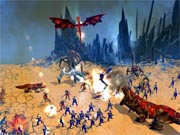Downtime in the dungeon: The Raid phenomenon in online games
 Hamburg - One identical image appears on 20 monitors scattered across Germany: a dragon, with a group of figures in the foreground preparing to face off against him.
Hamburg - One identical image appears on 20 monitors scattered across Germany: a dragon, with a group of figures in the foreground preparing to face off against him.
Yet the scene is frozen, since the "heroes" are off taking care of other issues: Gnygnyg and Shavon are just standing around because the people normally behind the keyboard have headed off to walk the dog. Chanay takes advantage of the break to bring his daughter to bed. This kind of scene has become commonplace for more and more people, reflecting how the online gaming "raids" have developed into a popular sport.
"Raid" here is used in the sense of what the Vikings or Huns did to unsuspecting villages. Some unknown developer came up with the idea of referring to the most difficult quests for online role playing games as "raids." And today, at any given time, 12, 24, or even 100 people will log onto a computer game to join in on a communal raid action aimed at bringing down their virtual opponents.
Just a few years ago, raids were the domain of hardcore players. The trend has now moved onto adult couples or parents with young children who would prefer excursions into dark catacombs over an evening in front of the television.
"Raid evenings have come to be as accepted as a leisure activity in the private sphere as a round of bridge used to be," says Olaf Wolters from Federal Association of Interactive Entertainment Software (biu) in Berlin.
"You can really make the argument that raids have turned into a kind of popular sport," says Hendrik Weins from Munich-based Gamestar magazine.
That's because there's more to a raid than just a joint battle against a seemingly superior opponent. Many players enjoy the chance to communicate with their fellow party members over the course of campaigns, which often last several hours.
"It's considered a standard part of the experience to put on a set of headphones and chat with one another," Weins says.
This social aspect of the game developed in reaction to practical needs: the developers generally design the opponents' strengths so that certain actions must be performed by individual players at a specific point in time.
It's faster and easier for the "raid leader" to bark out commands about what needs to be done than to use any other form of communication. It's precisely this verbal communication that helped make raids interesting for the masses.
In the quiet moments, there's time to shoot the breeze, as during a game night around a table with friends. The key difference between real social situations and those in the game, though, is that in the game the players don't see one another at all, only hear them. "But if you play online with people whom you know privately as well, then it's even nicer," Weins says.
Women are also relatively well represented in the raid movement. "The social aspect is a big one for me, the interaction with other people," says Lora, a female gamer. She has been joining her husband and grown son for several years now in various games.
The raids also often blossom into virtual friendships. Many of the players get together several times a week. "Many guilds and raid communities get together in the real world as well," Wolters says. Sometimes this can lead to surprises, however. After all, few muscle- bound paladin in the gaming world can look striking in real life as well. (dpa)